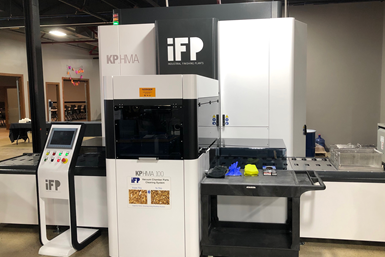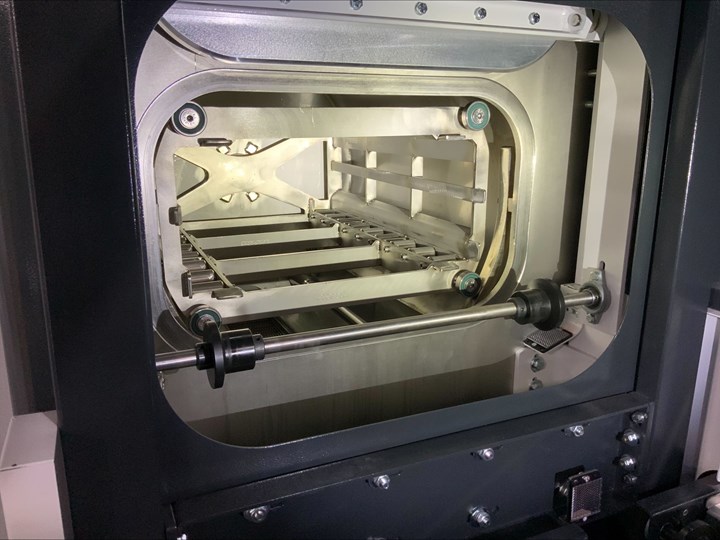
All automation connected to the iFP KP 100 vacuum degreaser is controlled by the management software. The software, programmed by iFP Europe, observes the procedures provided by the Industry 4.0 standard. Source: Gosiger
A lack of labor resources, difficulty reaching cleaning specifications and environmental standards are among the most common problems manufacturers face in their cleaning processes, according to Mike Bishop, east coast regional manager at Gosiger, and who provided information for this article.
AMPG (Accurate Manufactured Products Group) in Indianapolis, Indiana, was experiencing these frustrations with its cleaning process prior to implementing an automated vacuum degreasing system that positively influenced cleaning results, efficiency and costs.
This manufacturer of precision fasteners and components was using an immersion parts washer with a petroleum-based solvent. The process was not only labor-intensive, but ineffective and unhealthy for the machine’s operators.
When the shop began to search for a new way to clean its parts, an automated system was at the top of the list as well as one that could clean oils and chips off various metal types without the need for multiple cleaning chemistries. The management team also hoped to eliminate the use of compressed air to dry all part types and eliminate solvent mist. Ultimately, the shop wanted a long-term solution for cleaning without risk of future Environmental Protection Agency (EPA) solvent bans.
The iFP automated vacuum degreaser parts washer, distributed by Gosiger, checked all the boxes for AMPG. Most importantly, the machine washed 10 million parts at the shop in 2023, while saving the business from paying fees to plating vendors that charged for unclean parts.

The wash chamber of the iFP KP100 can hold two standard baskets (standard basket dimensions are 471 mm L x 321 mm W x 200 mm H). Source: AMPG
A parts washer that did not clean
Prior to the implementation of its vacuum degreaser in 2018, AMPG was not only struggling to keep up with a recent part volume increase with its purchase of more Swiss lathes, but its cleaning process was ineffective. The petroleum-based cleaning solvent used by the company’s immersion parts washer was not adequately removed from the parts being cleaned. When preparing the parts for shipment, solvent often dripped out of part cavities, leaking onto the shipping boxes. This issue often led to shipment refusals.
But even when shipments were successful, meeting the cleaning standards of the recipient often was not. Because the parts were still dirty with solvent, cutting oil or metal chips, the zinc and black oxide plating companies to which AMPG was shipping would charge cleaning fees prior to processing the parts.
The shop’s work environment was also compromised because of the inefficient cleaning process. To dry what were supposed to be clean parts coming out of the washer, operators used compressed air. This process created solvent mist and a large fog cloud in the shop that was unhealthy for the employees.
Out with the old, in with the new
The vacuum degreaser, considered an automated system, typically necessitates 20 minutes of operator attendance out of every hour. The operator places baskets of dirty parts onto the machine and then removes the baskets of clean parts. At the start of the cleaning process, the operator loads four washing baskets in a queue and then walks away from the machine. At that point, the system takes over and starts washing. Once complete, the system’s automation will unload the product and load the next queued wash load.
The automated iFP vacuum degreaser only requires about 20 minutes out of an hour of an operator’s time to load and unload baskets. Video source: AMPG
Besides the vacuum degreaser, the 130,000-square-foot headquarters houses nine large diameter turning centers with bar feeders, seven 20-mm Star Swiss lathes with bar feeders, 43 32-mm Star Swiss lathes with bar feeders, four 38-mm Star Swiss lathes with bar feeders, four thread rollers and two milling centers. The facility runs 24/7/365 with 63 full-time employees.
Clean, dry parts, finally!
Finally, AMPG could enjoy all the advantages this vacuum degreasing system provides. It not only cleans cutting oils and metal chips off the parts but leaves them bright and shiny, unlike the immersion cleaner’s results. And because this cleaning process has no air voids, cleaning chemistry can effectively access all complex parts features, such as blind holes and internal threads that are often challenging to penetrate and cleanse.
Vacuum drying is another benefit of the iFP system. By pulling a deep vacuum on the washing chamber, all the solvent is evaporated from the chamber and off the parts without creating fog in the shop. Not needing to dry the parts coming out of the system was a huge labor savings for AMPG as well.
By using modified alcohol as the cleaning chemistry in the vacuum degreaser, there were no concerns with the materials that must be washed, which include steel, stainless steel, aluminum, brass, titanium and Monel. And according to Gosiger, it is a future-proofed solvent. Modified alcohol is not classified as an HAP (hazardous air pollutant) by the EPA, it has low GWP (global warming potential), is halogen compound free, it does not contain CFC, HFEs, or HFCs substances, and it does not contain PFAS substances.
Although AMPG’s capacity has grown since it first implemented the iFP unit, the cleaning process has continued to provide the business with its cleaning needs. Now, the shop floor houses 70 lathes, and the one vacuum degreaser has no problem keeping up with the part volume increase.
Related Content
Replacing Open-Top Vapor Degreasing in Aerospace Manufacturing
Options and considerations for cleaning aerospace parts as regulations tighten on vapor degreasing solvents.
Read MoreTop Shop Emphasizes Dedication, Work Ethic
With a primary focus on aerospace and defense work, American Metaseal Corp. of Arbutus, Maryland, has qualified as a Top Shop on multiple occasions.
Read MoreVapor Degreasing Cleaning Fluids for Precision Cleaning
Tergo XCF2 cleaning solution is designed to meet diverse industrial technical cleaning needs with formulas that deliver reliable and repeatable cleaning performance.
Read MoreReplacing Discontinued Vapor Degreasing Fluids – 3 Things to Consider
What do you do when you learn your trusted line of vapor degreasing cleaning fluids will soon be discontinued? Elizabeth Norwood of MicroCare discusses what you should keep in mind when replacing discontinued vapor degreasing fluids.
Read MoreRead Next
Cost-Effective Cleaning with Vapor Degreasing
With modern equipment and solvents, vapor degreasing is a safe, cost-effective, and environmentally acceptable cleaning method.
Read MoreReplacing Discontinued Vapor Degreasing Fluids – 3 Things to Consider
What do you do when you learn your trusted line of vapor degreasing cleaning fluids will soon be discontinued? Elizabeth Norwood of MicroCare discusses what you should keep in mind when replacing discontinued vapor degreasing fluids.
Read MoreReplacing Open-Top Vapor Degreasing in Aerospace Manufacturing
Options and considerations for cleaning aerospace parts as regulations tighten on vapor degreasing solvents.
Read More























